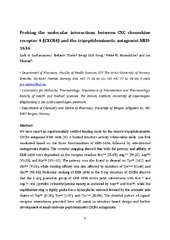| dc.description.abstract | Positron emission tomography is a non-invasive imaging modality allowing visualization and quantification of a wide variety of physiological and biochemical processes or of a specific lowdensity
protein target. Some examples are blood flow, glucose consumption, fatty acid
metabolism or detection and quantification of cell surface receptors in particular tissues. Within the spectrum of available positron emitters, fluorine-18 is a particularly attractive radionuclide
due to its favourable nuclear and chemical properties. One prerequisite to performing an
investigation with positron emission tomography (PET) is the availability of suitable radiopharmaceuticals. The selection, preparation, and preclinical evaluation of a new radiopharmaceutical are addressed in particular by the field of radiopharmaceutical chemistry. Currently, [18F]FDG and to a lesser extent other small molecular weight compounds have become
important clinical tracers for imaging of malignancies and other disease conditions. So far [18F]FDG, [18F]NaF and [18F]fluorodopa are the only three PET radiopharmaceuticals for 18Ffluorine
listed in the USP. Peptides labelled with 18F have emerged as promising target-specific imaging probes. To date, very few 18F-labelled peptides have been subjected to human studies, compared to other small
compound based 18-fluoride tracers. The explanation for this is to a large extent the complicated and low yielding synthesis of 18F-peptides employed so far. Peptides are labile molecules containing a multitude of functional groups that are not compatible
with the conditions where [18F]fluorine is introduced. Peptides are therefore in general labelled indirectly by means of 18F-labeled prosthetic groups also called bifunctional labelling agents. Numerous 18F-prosthetic groups have been described and utilised for labelling of peptides. The
number of synthetic steps and the different chemistries for conjugation to the peptide are some of the important properties of a prosthetic group, and renders some of them unsuitable for labelling a wide range of peptides. Also, the synthesis time and ease of production plays an important role as
PET involves rapidly decaying isotopes and radiation exposure to PET manufacturing
professionals. In this thesis, a new 18F-prosthetic group based on the site-selective addition of the Nmethylaminooxy to different sets of model peptides functionalised with Michael acceptors and alkyl halides have been investigated. Two 18F-prosthetic groups were synthesised; one based on a butyl chain and the second with diethylene glycol unit, both modified with the Nmethylaminooxy
functionality and a tosyl group for the introduction of 18-fluorine. Radiolabelling experiments showed that the diethylene glycol derivative was sufficiently stable,
but not the butyl derivative. Both radioactive and non-radioactive experiments with peptides demonstrated that the 18F-prosthetic group reacted in a site-selective manner, and that peptides
modified with Michael acceptors such as nitrostyrene, maleimide and vinylsulfone gave better yields and more clean reactions as compared to the alkyl halides. Further investigations of the prosthetic group in conjunction with an RGD peptide modified with either a nitrostyrene or a vinylsulfone moiety in vitro and in vivo demonstrated that a biologically active peptide can be
radiolabelled using this methodology. In vitro experiments and in vivo studies in osteosarcoma tumour bearing mice gave evidence for that the 18F-N-methylaminooxy prosthetic group had good stability. The peptide conjugate bearing the vinylsulfone was found suitable for in vivo use, while
the nitrostyrene analogue on the other hand was too labile. Finally, a nicotinic acid based system, with direct labelling of active esters was investigated. The 6-[18F]fluoronicotinic-TFP ester
proved to be a very suitable prosthetic group that allows labelling of peptides rapidly and in two steps. In conclusion, new and useful 18F-prosthetic groups for labelling of peptides and biomolecules have been successfully developed for use in PET. | en |
| dc.description | The papers of the thesis are not available in Munin:
<br>1. Olberg, D.E., Hjelstuen, O.K., Solbakken, M., Arukwe, J., Karlsen,
H., and Cuthbertson, A.: 'A novel prosthetic group for site-selective labeling of peptides for positron emission tomography', Bioconjugate Chemistry 2008, 19 (6), 1301-1308 (American Chemical Society - publisher's restrictions). Available at <a href=http://dx.doi.org/10.1021/bc800007h>http://dx.doi.org/10.1021/bc800007h</a>
<br>2. Olberg, D.E., Hjelstuen, O.K., Solbakken, M., Arukwe, J.M., Dyrstad,
K., and Cuthbertson, A.: 'Site-specific addition of an 18F-N-methylaminooxy-containing prosthetic group to a vinylsulfone
modified peptide', Journal of Labelled Compounds and Radiopharmaceuticals, Volume 52 Issue 14, Pages 571 - 575 (Wiley - publisher's restrictions). Available at <a href=http://dx.doi.org/10.1002/Jlcr.1686>http://dx.doi.org/10.1002/Jlcr.1686</a>
<br>3. Olberg, D.E., Cuthbertson, A., Solbakken, M., Arukwe, J.M., Kristian, A., Bruheim, S., Qu, H., and Hjelstuen O.K.: 'Radiosynthesis, biodistribution and preliminary evaluation of a novel [18F]fluorinated N-methylaminooxy conjugated to cyclic RGD peptides' (manuscript). Published version in Bioconjugate Chemistry, available at <a href=http://dx.doi.org/10.1021/bc1003229>http://dx.doi.org/10.1021/bc1003229</a>
<br>4. Olberg, D.E, Arukwe, J.M., Grace, D., Hjelstuen, O.K., Solbakken, M., Kindberg, G.M., and Cuthbertson A.: '6-[18F]Fluoronicotinic acid TFP-ester: A novel single-step prosthetic group for the labelling of biomolecules with fluorine-18', Forthcoming in Journal of Medicinal Chemistry (American Chemical Society - publisher's restrictions).
<br>Appendix: Available as "supporting information" to paper 1, at <a href=http://dx.doi.org/10.1021/bc800007h>http://dx.doi.org/10.1021/bc800007h</a> | en |


 English
English norsk
norsk


